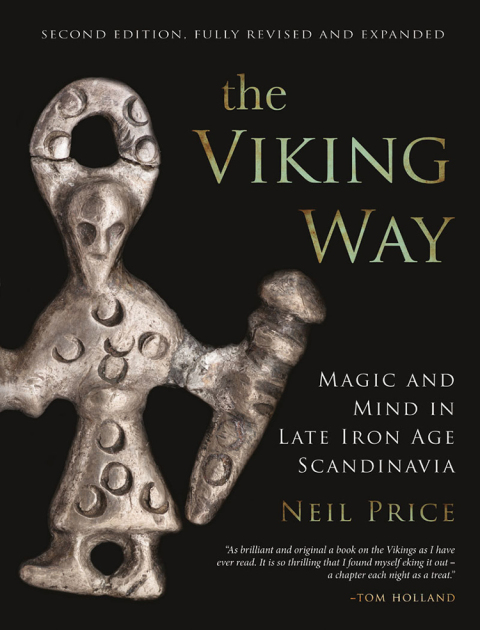Description
Efnisyfirlit
- Cover
- Title
- Copyright
- Dedication
- Contents
- List of figures and tables
- Abbreviations
- Preface to the first edition, 2002
- Preface to the second edition
- Acknowledgements to the second edition
- A note on language
- A note on seid and its analogues
- 1. Different Vikings? Towards a cognitive archaeology of the later Iron Age
- A beginning at Birka
- Textual archaeology and the Iron Age
- The Vikings in (pre)history
- The materiality of text
- Annaliste archaeology and a historical anthropology of the Vikings
- The Other and the Odd?
- Conflict in the archaeology of cognition
- Others without Othering
- Indigenous archaeologies and the Vikings
- An archaeology of the Viking mind?
- 2. Problems and paradigms in the study of Old Norse sorcery
- Entering the mythology
- Research perspectives on Scandinavian pre-Christian religion
- Philology and comparative theology
- Gods and monsters, worship and superstition
- Religion and belief
- The invisible population
- The shape of Old Norse religion
- The double world: seiðr and the problem of Old Norse ‘magic’
- The other magics: galdr, gandr and ‘Óðinnic sorcery’
- Seiðr in the sources
- Skaldic poetry
- Eddic poetry
- The sagas of the kings
- The sagas of Icelanders (the ‘family sagas’)
- The fornaldarsögur (‘sagas of ancient times’, ‘legendary sagas’)
- The biskupasögur (‘Bishops’ sagas’)
- The early medieval Scandinavian law codes
- Non-Scandinavian sources
- Seiðr in research
- 3. Seiðr
- Óðinn
- Óðinn the sorcerer
- Óðinn’s names
- Freyja and the magic of the Vanir
- Seiðr and Old Norse cosmology
- The performers
- Witches, seeresses and wise women
- Women and the witch-ride
- Men and magic
- The assistants
- Towards a terminology of Nordic sorcerers
- The performers in death?
- The performance
- Ritual architecture and space
- The clothing of sorcery
- Masks, veils and head-coverings
- Drums, tub-lids and shields
- Staffs and wands
- Staffs from archaeological contexts
- Narcotics and intoxicants
- Charms
- Songs and chants
- The problem of trance and ecstasy
- Engendering seiðr
- Ergi, níð and witchcraft
- Sexual performance and eroticism in seiðr
- Seiðr and the concept of the soul
- Helping spirits in seiðr
- The domestic sphere of seiðr
- Divination and revealing the hidden
- Hunting and weather magic
- The role of the healer
- Seiðr contextualised
- 4. Noaidevuohta
- Seiðr and the Sámi
- Sámi-Norse relations in the Viking Age
- Sámi religion and the Drum-Time
- The world of the gods
- Spirits and Rulers in the Sámi cognitive landscape
- Names, souls and sacrifice
- Noaidevuohta and the noaidi
- Rydving’s terminology of noaidevuohta
- Specialist noaidi
- Diviners, sorcerers and other magic-workers
- The sights and sounds of trance
- ‘Invisible power’ and secret sorcery
- Women and noaidevuohta
- Sources for female sorcery
- Assistants and jojker-choirs
- Women, ritual and drum magic
- Female diviners and healers in Sámi society
- Animals and the natural world
- The female noaidi?
- The rituals of noaidevuohta
- The role of jojk
- The material culture of noaidevuohta
- An early medieval noaidi? The man from Vivallen
- Sexuality and eroticism in noaidevuohta
- Offence and defence in noaidevuohta
- The functions of noaidevuohta
- The ethnicity of religious context in Viking-Age Scandinavia
- 5. Circumpolar religion and the question of Old Norse shamanism
- The circumpolar cultures and the invention of shamanism
- The shamanic encounter
- The early ethnographies: shamanic research in Russia and beyond
- Shamanism in anthropological perspective
- The shamanic world-view
- The World Pillar: shamanism and circumpolar cosmology
- The ensouled world
- The shamanic vocation
- Gender and sexual identity
- Eroticism and sexual performance
- Aggressive sorcery for offence and defence
- Shamanism in Scandinavia
- From the art of the hunters to the age of bronze
- Seiðr before the Vikings?
- Landscapes of the mind
- The eight-legged horse
- Tricksters and trickery
- Seiðr and circumpolar shamanism
- Two analogies on the functions of the seiðr-staff
- The shamanic motivation
- Towards a shamanic world-view of the Viking Age
- 6. The supernatural empowerment of aggression
- Seiðr and the world of war
- Valkyrjur, skaldmeyjar and hjálmvitr
- Female warriors in reality
- The valkyrjur in context
- The names of the valkyrjur
- The valkyrjur in battle-kennings
- Supernatural agency in battle
- Beings of destruction
- Óðinn and the Wild Hunt
- The projection of destruction
- Battle magic
- Sorcery for warriors
- Sorcery for sorcerers
- Seiðr and battlefield resurrection
- Seiðr and the shifting of shape
- Berserkir and ulfheðnar
- The battlefield of animals
- Ritual disguise and shamanic armies
- Ecstasy, psychic dislocation and the dynamics of mass violence
- Homeric lyssa and holy rage
- Predators and prey in the legitimate war
- Weaving war, grinding battle: Darraðarljóð and Grottasǫngr in context
- The ‘weapon dancers’
- 7. The Viking way
- A reality in stories
- The invisible battlefield
- Material magic
- Viking women, Viking men
- 8. Magic and mind
- Receptions and reactions
- Cracks in the ice of Norse ‘religion’
- Walking into the seiðr: contested interpretations of Viking-Age magic
- Questioning Norse ‘shamanism’
- Staffs and spinning
- Queering magic?
- The social world of war
- The Viking mind: a conclusion
- References
- Primary sources, including translations
- Pre-nineteenth-century sources for the early Sámi and Siberian cultures
- Secondary works
- Sources in archive






Reviews
There are no reviews yet.